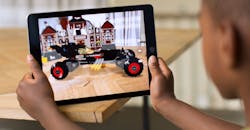Augmented reality (AR) can be implemented in a number of ways. One of the primary approaches is to use AR glasses; another is to use a tablet or smartphone equipped with a camera (e.g., games like Pokémon Go). Fundamentally, both approaches aim to deliver a view of reality overlaid with computer-generated content.
One might think that Apple’s new ARKit and Google’s ARCore will rescue developers from AR oblivion, but a quick look around highlights a plethora of AR options targeting a range of platforms that are already available. Having heavy hitters like Apple and Google in the mix will not hurt, but the likes of Microsoft and Intel have been hitting the AR gong for quite a while already. Likewise, solutions like Scope AR’s WorkLink (Fig. 1) have been available for a number of years.
Google has also been doing work with its Google Glass, which disappeared for a while but is back as an industrial tool (Fig. 2). The main difference between this effort and its ARCore is the target audience. The Google Glass hardware is actually paired with software from Google solution providers that work directly with the customers.
Apple’s ARKit and Google’s ARCore target iOS and Android developers respectively, with smartphones being the target platform. These look to take advantage of the massive smartphone population that is dominated by iOS and Android. Likewise, even midrange smartphones are coming equipped with high-resolution cameras that blend well with AR solutions. Of course, Apple and Google’s offerings highlight the importance of AR.
“Google and Apple’s AR technology is exciting and confirms what we’ve believed at Meta since before our inception: Augmented reality is the next paradigm of computing,” said David Oh, head of developer relations at Meta. “We are working closely with developers to design the most productive and intuitive AR applications, in line with Meta’s just-published Spatial Design Guidelines. Once these applications offer a seamless, natural and productive experience, we are excited to see how quickly and easily these high-quality apps will be ported to glasses and drive the entire industry forward.”
Apple’s ARKit (Fig. 3) uses Visual Inertial Odometry (VIO) to track what the iPad or iPhone camera sees and allows mapping of content onto the screen presentation. It uses the built-in sensor system in these devices using the Core Motion framework. Of course, this is the same type of thing that is done within any AR framework or software development kit (SDK). It is just a matter of using different nomenclature. At this point ARKit requires an Apple A9 and A10 processor that is in the latest versions of Apple’s hardware. The support will be found in iOS 11 and Xcode 9 development tools.
Google’s ARCore targets Google Android (Fig. 4). ARCore is a relative newcomer to the AR space. Some of its details are a bit sparse. Like ARKit, it supports third-party gaming engines like Unity and Unreal. This is key for generating 3D images to overlay virtual images in AR mode.
ARKit and ARCore have the advantage over third-party solutions because of their integration with the operating system. Likewise, this support will come as part of the operating system package versus an application. This, in theory, will provide potential integration of multiple AR apps in the future.
AR SDKs typically hide much of the underlying complexity of sensor integration, scene analysis, and so on. Applications can then utilize this information and merge it with 2D and 3D content that is then displayed and manipulated by application users. This may sound simple but is actually quite complex, as details like lighting need to be taken into account.
Likewise, many AR applications do not simply overlay information but require that this information be positioned based on camera images. This requires image recognition and scene analysis. This can require significant amounts of computing power, and even artificial intelligence and machine learning come into play, as these tools are used to recognize items in a scene and even the relationship between objects.
ARKit and ARCore work within their respective programming platforms and frameworks. This allows access to other app development support from buttons to gesture recognition, since the AR aspect will not be the only part of the app that a user will work with. These SDKs also work with other 3D tools that already exist, such as Apple’s SceneKit (which supports 3D animation) and SpriteKit (which handles 2D animation).
I did mention that there were other solutions out there—including support from Microsoft and Intel—but here are a few more that have SDKs and plugins that have cross platform support, including iOS and Android: ARTookKit, EasyAR, Kudan, Maxst, Vuforia, Wikitude, and XZIMG. Many include additional features like face recognition.
All of these can be used to create AR games and applications, but they will require a significant amount of coding and understanding of the SDK to deliver an AR application. Developers will need to know whether they want to work at this level or work at customizing an existing solution like Scope AR’s WorkLink.
If anyone is wondering what all that computing power in a smartphone will be used for, they should look at the apps being generated using these toolkits and frameworks.
About the Author
William G. Wong
Senior Content Director - Electronic Design and Microwaves & RF
I am Editor of Electronic Design focusing on embedded, software, and systems. As Senior Content Director, I also manage Microwaves & RF and I work with a great team of editors to provide engineers, programmers, developers and technical managers with interesting and useful articles and videos on a regular basis. Check out our free newsletters to see the latest content.
You can send press releases for new products for possible coverage on the website. I am also interested in receiving contributed articles for publishing on our website. Use our template and send to me along with a signed release form.
Check out my blog, AltEmbedded on Electronic Design, as well as his latest articles on this site that are listed below.
You can visit my social media via these links:
- AltEmbedded on Electronic Design
- Bill Wong on Facebook
- @AltEmbedded on Twitter
- Bill Wong on LinkedIn
I earned a Bachelor of Electrical Engineering at the Georgia Institute of Technology and a Masters in Computer Science from Rutgers University. I still do a bit of programming using everything from C and C++ to Rust and Ada/SPARK. I do a bit of PHP programming for Drupal websites. I have posted a few Drupal modules.
I still get a hand on software and electronic hardware. Some of this can be found on our Kit Close-Up video series. You can also see me on many of our TechXchange Talk videos. I am interested in a range of projects from robotics to artificial intelligence.






